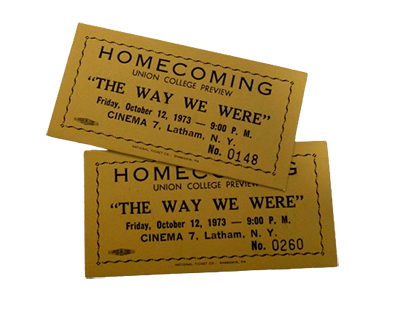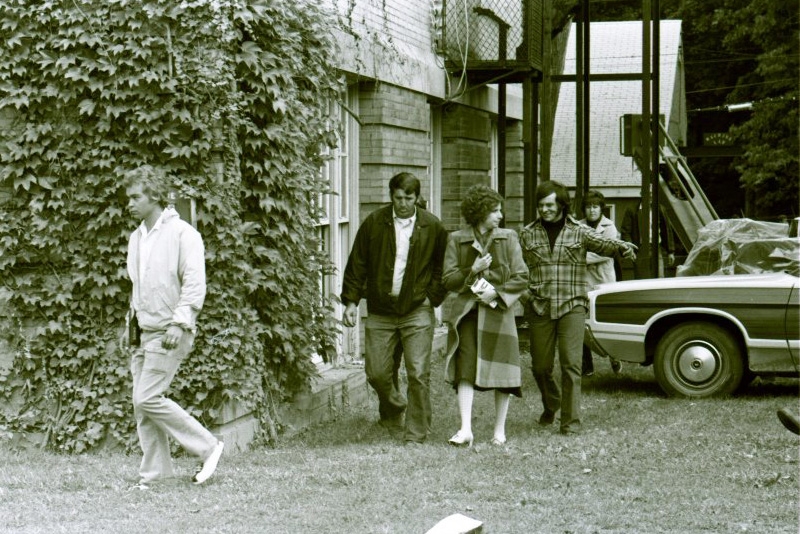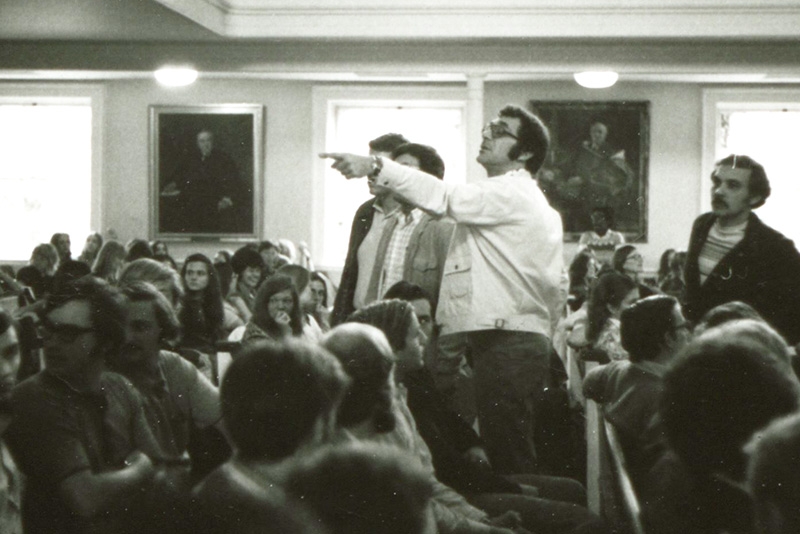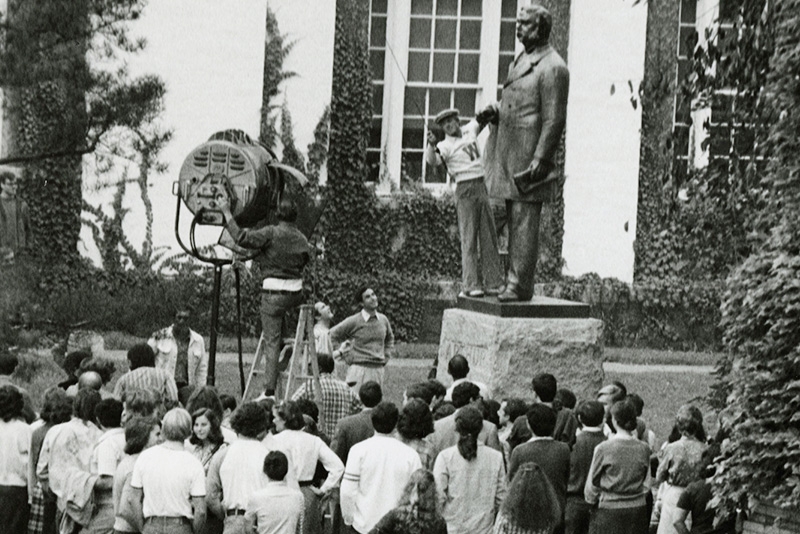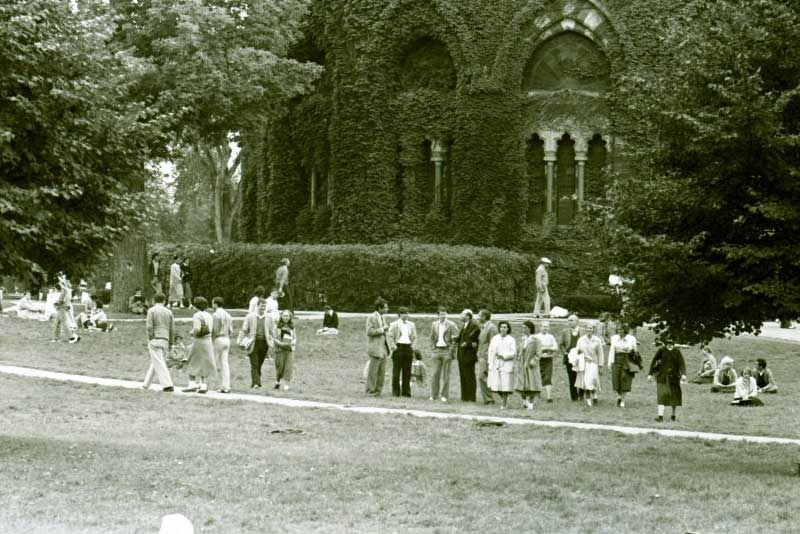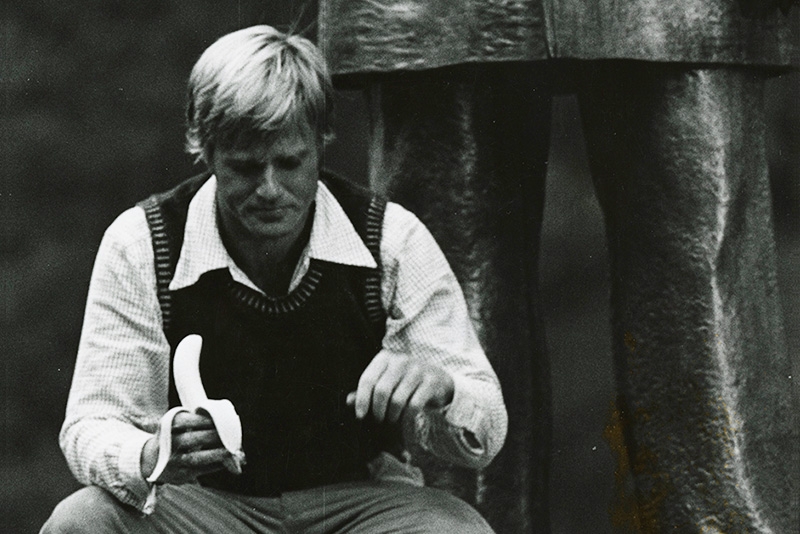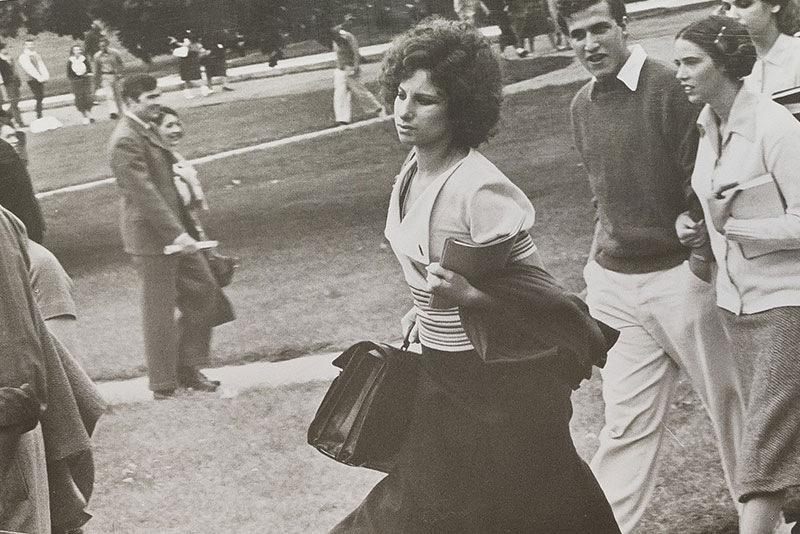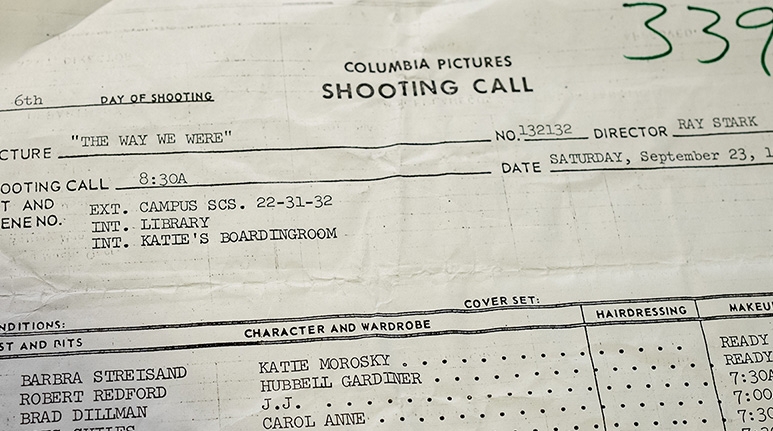It is early fall of 1937, and the leaves on campus are beginning to turn, a tease to the spectacular landscape to follow.
Two students with little in common cross paths, she a Jewish anti-war activist, he a stunningly handsome WASP athlete. The introduction of Katie Morosky and Hubbell Gardiner at Wentworth College sparks a spectacular romance across decades that ultimately ends in heartbreak.
Except this romance wasn’t real. Instead, many people with a Union connection are familiar with the Hollywood tale that became one of the biggest tearjerkers of all time, “The Way We Were.” A number of iconic scenes were shot on campus and the surrounding area in the fall of 1972, giving students and others an opportunity to get up close and personal with Hollywood royalty, Barbra Streisand and Robert Redford.
This month marks the 50th anniversary of the theatrical release of the film, which coincides with two new books about its production, “The Way We Were: The Making of a Romantic Classic,” by Tom Santopietro, and Robert Hofler’s “The Way They Were: How Epic Battles and Bruised Egos Brought a Classic Hollywood Love Story to the Screen.”
Theaters nationwide are also hosting special anniversary screenings of the film, including Proctors Theatre in Schenectady Oct. 19.
From its opening credits featuring Redford’s Hubbell sprinting through Jackson’s Garden to Streisand’s Katie leading a boisterous peace rally in front of an ivy-covered Nott Memorial, the movie and the College remain inextricably linked. The connection is often cited in college guidebooks and is a source of pride and nostalgic reckoning for many alumni.
Yet if not for unforeseen circumstances and frankly, pure luck, Union’s association with a movie the American Film Institute considers one of the top 10 romances of all time would not have happened.
Playwright Arthur Laurents, who wrote the script, had attended Cornell University and envisioned his alma mater for the shots of Katie and Hubbell during their college years.
The idea was scrapped after location scouts visited Cornell and decided the juxtaposition of modern buildings and aged ivy-covered dormitories wouldn’t work.
“The combination of old and new was unsightly, unbalanced contemporary America,” Laurents said, according to Santopietro’s book.
Producers then zeroed in on Williams College, which granted permission for three weeks of filming in late summer. When script delays pushed the production dates into the academic year, Williams backed out, not wanting to disrupt the start of classes.
That opened the door for Union.
There are conflicting versions on how Union got on the radar of producers, but one thing is certain: parts of campus retained the authentic setting of the time period needed for the early scenes of Katie and Hubbell.
Union also offered another advantage that Williams passed on.
“Classes were in session, and students could work as extras on the film at $15 a day,” writes Hofler.
President Harold C. Martin informed the campus that the College had been approached by Columbia Pictures and “after a good deal of discussion, and with some trepidation, we have agreed, thinking that there’ll be enough fun and ‘profit’ – in the form of public relations, if nothing else – to make the project worth the turmoil it will undoubtedly produce.”
He added, “I haven’t any idea what the film is about, but I know something about college life in 1937 (my graduation year), so I know what it’s probably not about. It’s a new experience for us, and I hope everyone will enjoy it while it occurs, bear a hand amiably, and recognize that the real payoff will come from looking back on an unusual interlude.”

Many students were cast as extras in the movie for $15 a day.
“Two weeks of location shooting in Schenectady, New York, wouldn’t make anyone soon forget Paris, but The Way We Were had found its on-screen home,” writes Santopietro.
Work quickly began to transform parts of campus into a movie set, including Hale House, Old Chapel, Alumni Gymnasium and even the Chester Arthur statue. Hundreds of extras were recruited at $15 a day for 12-hour work days. To match the 1930s time period, requirements included short hair for men and long skirts for women.
“It was an exciting time on campus,” recalls Gail Goodman-Snitkoff ’74. She was among hundreds of students who filled Memorial Chapel hoping to get cast as an extra. She appears in a couple of scenes. “It was so much fun to be in a movie.”
Redford, she said, was very friendly on the set, often emerging from his trailer to toss a football around with the students. Streisand, on the other hand, appeared shy and reclusive, coming out of her trailer only to shoot her scenes.
“We were told not to go up to them, not to disturb them,” Goodman-Snitkoff said. “We were only to engage if they wanted to engage.”
Andrew Richman’s ’73 brush with fame barely lasted 15 minutes. The film’s director, Sydney Pollack, would walk down the aisle of Memorial Chapel and point to a person to indicate they had been chosen as an extra. Richman tried to get Pollack’s attention.
“Hey Sydney, how about a part for a Jewish kid from Brooklyn,” he blurted out. Pollack, also Jewish and from Brooklyn, pointed at Richman and said, ‘Go get a costume.”
Soon, though, Richman grew tired of sitting outside for hours in the heat while waiting for scenes to be shot.
“It was hot, very hot and uncomfortable,” said Richman, an internal medicine specialist in Florida. “There was no glory in the part, and I was never going to become a movie star. So I gave my costume to another student and told him to take the part, and I would give him the check when it came.”
The presence of Redford and Streisand captivated the campus. As Redford prepped for a scene in which he wins a race during a collegiate track meet, he removed his warmup suit.
“I just never thought I’d see Robert Redford taking off his pants in Schenectady,” a female bystander sighed.
After about 10 days filming on campus and in nearby Ballston Spa, the production packed up and headed to New York City and Los Angeles to shoot additional scenes.
The College received no fee for allowing its space to be used for filming, but the studio did reimburse Union nearly $6,000 for expenses, including overtime for campus safety officers, building materials and landscaping costs.
The campus community would need to wait a year before they could see how the film turned out. Four days before the movie’s world premiere at Loew’s State Theatre in Times Square, Columbia Pictures held a special screening for Union during Homecoming Weekend on Oct. 12, 1973. Nearly 500 people packed the Cinema 7 in Latham, 15 minutes from campus.
Reviews for the movie were mixed. Variety called it a “distended, talky, redundant and moody melodrama.” Perhaps Pauline Kael, the legendary critic at the New Yorker, summed it up best in the opening paragraph of her review.
Calling the movie a fluke, Kael writes it is a “torpedoed ship full of gaping holes which comes snugly into port. The cinematography is ugly; several scenes serve no purpose, and the big dramatic sequences come butting in, like production numbers, out of nowhere…yet the damned thing is enjoyable. It stays afloat because of the chemistry of Barbra Streisand and Robert Redford.”
Nominated for six Academy Awards, the film won two: Best Original Song and Best Original Score. It is also an enduring element of pop culture, referenced in episodes of “The Simpsons,” “Friends,” “Gilmore Girls,” “Sex and the City” and others.
Special Collections contains a plethora of memorabilia related to the filming on campus, including photo negatives, news clippings and call sheets outlining the daily shooting schedule. Archivist Joseph Lueck recently unearthed “Recreating a Memory,” an original 16mm reel of a promotional film about the making of the movie. Gifted to the College by Columbia Pictures, the 10-minute clip contains rarely-seen candid shots of the stars on campus. A version is available on YouTube.
So as the 50th anniversary of the movie arrives this month, what do Redford and Streisand have to say about their time as fictional characters on campus? Representatives for both said neither were available to comment.
In her upcoming memoir, “My Name is Barbra,” Streisand does mention the College in a lengthy section about the movie.
“We started shooting in September 1972 at Union College in Schenectady, New York,” she writes, according to an advance excerpt in Vanity Fair. “I was 30 years old, Bob was 36, and we were supposed to be in our early 20s, but no one objected. If the story is strong and the actors are good, the audience suspends disbelief. For the first few weeks, a parasite I had contracted in Africa was still bothering me. I had a constant headache and found it hard to focus. Everything was hazy and surreal. I couldn’t keep food down. I was so skinny my legs looked like toothpicks…”
For those students who had a front row seat to fame that fall, the excitement of having Hollywood visit campus has not faded over time.
Last June, Goodman-Snitkoff attended a special screening on campus of “The Way We Were,” as part of her husband’s 50th ReUnion. Like Katie Morosky and Hubbell Gardiner, she and Lou ’73 met in college, at a Hillel event in October 1970. Unlike the doomed fictional characters, though, the Snitkoffs have fared better. Married for 47 years, both are retired, she after teaching for 27 years at the Albany College of Pharmacy and Health Services, he as an internist and founding member and chief medical officer of CapitalCare Medical Group and vice president for the Ellis Hospital Medical Group in Schenectady.
“I still get emotional watching the movie,” said Goodman-Snitkoff. “It takes me back. I still get a kick out of it, not only because of the story, but the fact we were there on campus when it was filmed.”
This is a rare mini-documentary about the production of the movie.
